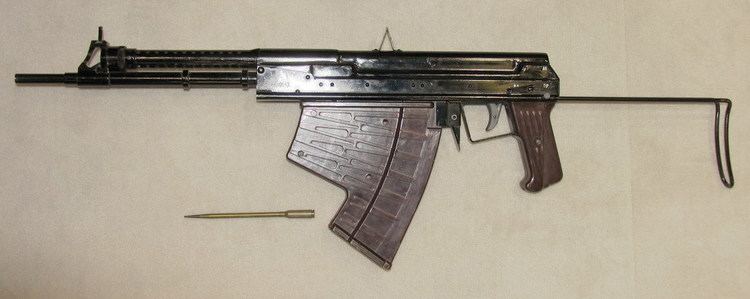 | ||
An underwater firearm is a firearm designed for use underwater. They are in the arms inventories of many nations. A common feature of underwater firearms or needleguns is that they fire flechettes or spear-like bolts fired by pressurised gas, instead of standard bullets.
Contents
History
Underwater firearms were first developed in the 1960s during the Cold War as a way to arm frogmen.
Design
Because standard bullet ammunition does not work well underwater, a common feature of underwater firearms is that they fire flechettes instead of standard bullets.
The barrels of underwater pistols are typically not rifled. Rather, the fired projectile maintains its ballistic trajectory underwater by hydrodynamic effects. The lack of rifling renders these weapons relatively inaccurate when fired out of water. Underwater rifles are more powerful than underwater pistols and more accurate out of water, but underwater pistols can be manipulated more easily underwater.
Among the many engineering challenges in designing underwater firearms is that of developing a weapon which can be effective both underwater and out of water. The ASM-DT amphibious rifle is an early example of such a weapon. First fielded by the Russian special forces in 2000, the folding-stock ASM-DT amphibious rifle is capable of firing two kinds of ammunition, both of 5.45 mm caliber:
- 5.45×39mm rifle cartridge (7N6 enhanced penetration variant) for above water use
- 5.45x39mm MGTS variant for underwater use. The projectile in this case is a steel dart, 120 mm (4.7 in) in length.
When used against underwater targets, an underwater firearm may have a longer range and more penetrating power than spearguns. This is useful in such situations as shooting an underwater intruder where the projectile may have to first penetrate a reinforced dry suit, or a protective helmet (whether air-holding or not), or a thick tough part of his breathing set and its harness, or the plastic casing or transparent cover of a small underwater vehicle.
Supercavitating ammunition
Supercavitating ammunition that functions better underwater has been developed by Defence & Security Group (DSG), a Norwegian company. The Multi-Environment Ammunition (MEA) series supercavitating rifle ammunition, developed and marketed by DSG, is anticipated to be useful for certain special operations, including underwater warfare. These include defensive applications such as diver protection, and offensive applications such as neutralizing enemy divers, VBSS (visit, board, search, and seizure) operations, MIO (maritime interception operations), GOPLATS (Gas and oil platform) boarding operations, speedboat interdiction and neutralization, anti-submarine warfare, anti-torpedo operations, and certain counter-piracy operations.
The ballistic characteristics of MEA series ammunition allows the user to fire at an underwater target from above the water, or an above-the-water target from underwater, or from underwater at a target which is also underwater. This ammunition allows the user to fire from above the surface into the water at a very low angle of incidence—in some cases as low as two degrees—without ricochet. After entering the water, the bullet will continue its original trajectory. The user when aiming the gun needs to compensate for the refractive index of the water (roughly 1.333 for fresh water at 20 °C).
MEA series supercavitating ammunition is currently available in the following calibers:
The underwater capabilities of MEA series supercavitating ammunition allow it to be used for Unmanned underwater vehicle (UUV) applications. The armed UUVs can be used in both offensive and defensive underwater warfare operations. Using the .50 BMG supercavitating cartridge, an armed UUV can potentially destroy steel-hulled underwater objects from a distance of 60 meters, or could potentially hit a target 1,000 meters in the air from a location 5 meters below the surface.
